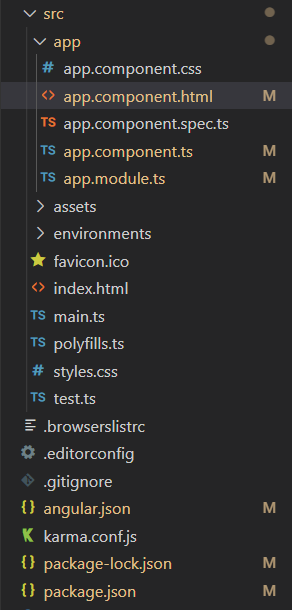Angular PrimeNG Skeleton Properties
Last Updated :
03 Oct, 2022
Angular PrimeNG is an open-source front-end UI library that has many native Angular UI components which help developers to build a fast and scalable web solution. In this article, we will be seeing Angular PrimeNG Skeleton Properties.
The Skeleton Component is used as a placeholder while the data for the actual component is loading in the background. The properties of the skeleton component are listed below.
Angular PrimeNG Skeleton Properties:
- shape: This property specifies the shape of the skeleton component. It accepts string values. The options are “rectangle” and “circle”.
- size: This property specifies the size of the skeleton element.
- width: This property specifies the width of the skeleton component. It accepts string values and the default value is “100%”.
- height: This property specifies the height of the skeleton component. It accepts string values and the default value is “1rem”.
- borderRadius: This property specifies the values of the border radius of the skeleton. It takes the default value from the theme you have applied.
- animation: It specifies the animation to be applied to the skeleton. It accepts string values and the accepted values are “Wave” and “none”.
- style: It is the Inline style of the element.
- styleClass: It is the style class of the element.
Syntax:
<p-skeleton
shape="..."
width="..."
height="...">
</p-skeleton>
Creating Angular Application and Installing the Modules:
Step 1: Create an Angular application using the following command.
ng new appname
Step 2: After creating your project folder i.e. appname, move to it using the following command.
cd appname
Step 3: Finally, Install PrimeNG in your given directory.
npm install primeng --save
npm install primeicons --save
Project Structure: The project Structure will look like this after following the above steps:

Project Structure
Run the below command to run the application:
ng serve --open
Example 1: This example illustrates how to create rectangular and rounded skeleton elements using the borderRadius, height, and width properties.
app.component.html
<div
class="page-content"
style="height: calc(100vh - 149px)">
<h2 style="color: green">GeeksforGeeks</h2>
<h4>Angular PrimeNG Skeleton Properties</h4>
<h3>Rectangular Skeleton Elements</h3>
<p-skeleton
height="1rem"
width="50%"
styleClass="mb-4">
</p-skeleton>
<p-skeleton
height="2rem"
width="65%"
styleClass="mb-4">
</p-skeleton>
<p-skeleton
height="3rem"
width="80%"
styleClass="mb-4">
</p-skeleton>
<p-skeleton
height="4rem"
width="100%"
styleClass="mb-4">
</p-skeleton>
<h3>Rounded Skeleton Elements</h3>
<p-skeleton
height="1rem"
width="50%"
borderRadius="30px"
styleClass="mb-4">
</p-skeleton>
<p-skeleton
height="2rem"
width="65%"
borderRadius="30px"
styleClass="mb-4">
</p-skeleton>
<p-skeleton
height="3rem"
width="80%"
borderRadius="30px"
styleClass="mb-4">
</p-skeleton>
<p-skeleton
height="4rem"
width="100%"
borderRadius="30px"
styleClass="mb-4">
</p-skeleton>
</div>
|
app.component.ts
import { Component } from '@angular/core';
@Component({
selector: 'app-root',
templateUrl: './app.component.html',
})
export class AppComponent {
}
|
app.module.ts
import { NgModule } from '@angular/core';
import { BrowserModule } from '@angular/platform-browser';
import { FormsModule } from '@angular/forms';
import { BrowserAnimationsModule }
from '@angular/platform-browser/animations';
import { AppComponent } from './app.component';
import { SkeletonModule } from 'primeng/skeleton';
@NgModule({
imports: [
BrowserModule,
BrowserAnimationsModule,
FormsModule,
SkeletonModule
],
declarations: [AppComponent],
bootstrap: [AppComponent],
})
export class AppModule { }
|
Output:
Example 2: This example illustrates how to create the square and rounded skeleton elements using the size and shape properties.
app.component.html
<div
class="page-content"
style="height: calc(100vh - 149px)">
<h2 style="color: green">GeeksforGeeks</h2>
<h4>Angular PrimeNG Skeleton Properties</h4>
<h3>Square Skeleton Elements</h3>
<div class="flex align-items-center">
<p-skeleton
size="5rem"
styleClass="mr-4">
</p-skeleton>
<p-skeleton
size="8rem"
styleClass="mr-4">
</p-skeleton>
<p-skeleton size="13rem">
</p-skeleton>
</div>
<h3>Circular Skeleton Elements</h3>
<div class="flex align-items-center">
<p-skeleton
size="5rem"
shape="circle"
styleClass="mr-4">
</p-skeleton>
<p-skeleton
size="8rem"
shape="circle"
styleClass="mr-4">
</p-skeleton>
<p-skeleton
shape="circle"
size="13rem">
</p-skeleton>
</div>
</div>
|
app.component.ts
import { Component } from '@angular/core';
@Component({
selector: 'app-root',
templateUrl: './app.component.html',
})
export class AppComponent {
}
|
app.module.ts
import { NgModule } from '@angular/core';
import { BrowserModule } from '@angular/platform-browser';
import { FormsModule } from '@angular/forms';
import { BrowserAnimationsModule }
from '@angular/platform-browser/animations';
import { AppComponent } from './app.component';
import { SkeletonModule } from 'primeng/skeleton';
@NgModule({
imports: [
BrowserModule,
BrowserAnimationsModule,
FormsModule,
SkeletonModule
],
declarations: [AppComponent],
bootstrap: [AppComponent],
})
export class AppModule { }
|
Output:
Reference: http://primefaces.org/primeng/skeleton
Share your thoughts in the comments
Please Login to comment...